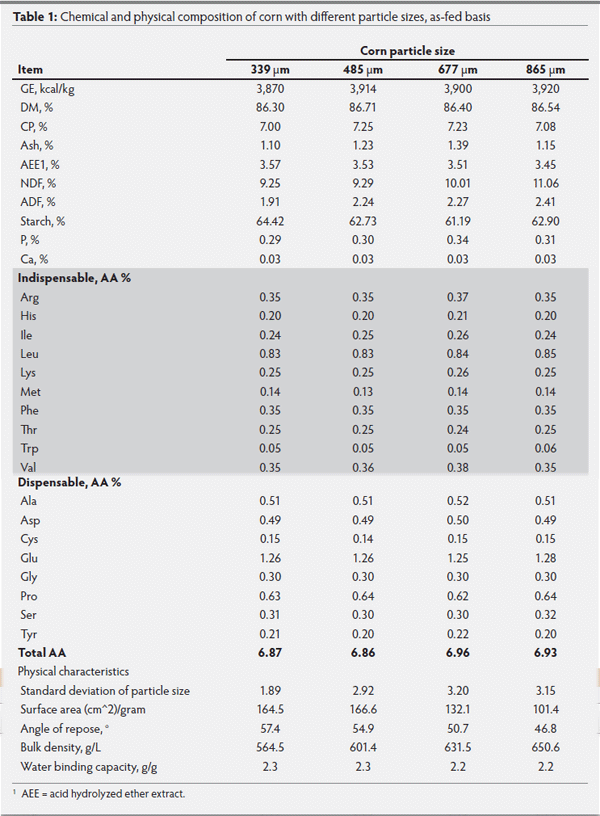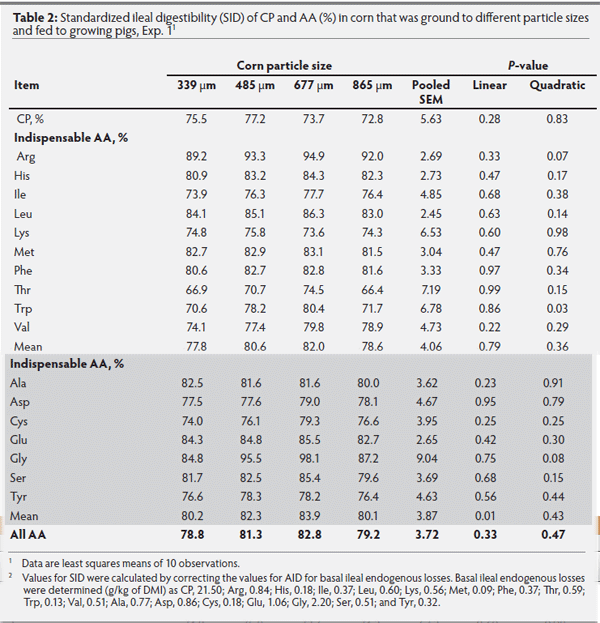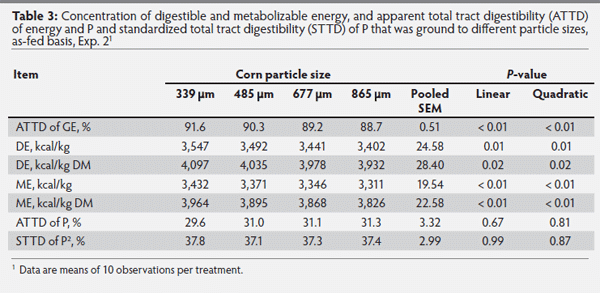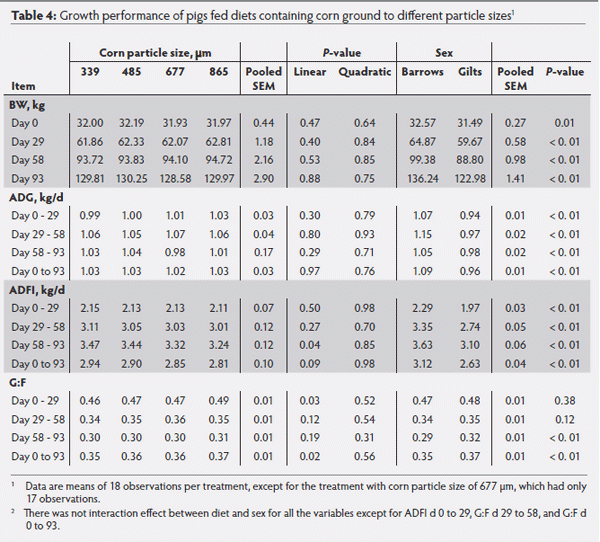Effects of reducing the particle size of corn on the digestibility of energy and nutrients and growth performance and carcass characteristics of growing - finishing pigs1
Published: July 7, 2014
By: Oscar Javier Rojas Martinez; Hans H. Stein, PhD (Department of Animal Sciences, University of Illinois)
Introduction
Grinding of feed ingredients is used to reduce the particle size and increase energy and nutrient digestibility (Wondra et al., 1995d; Laurinen et al., 2000; Mavromichalis et al., 2000; Kim et al., 2002) and it is usually accomplished with the use of either roller mills, hammer mills, or a combination of roller and hammer mills. It is currently recommended that corn grain be milled to an average particle size of approximately 640 - 650 μm (Wondra et al., 1995b; Kim et al., 2002), but it has also been documented that the apparent total tract digestibility (ATTD) of energy, DM, and N in corn fed to finishing pigs or sows increases as the particle size of the grain is reduced (Healy et al., 1994; Wondra et al., 1995a-d). It was also reported that there is a tendency for an increase in the SID of AA in soybean meal as particle size is reduced (Fastinger and Mahan, 2003), but there is no effect of particle size on the ATTD of P in distillers dried grain with solubles (DDGS; Liu et al., 2012). However, there are no data that demonstrate the effects of particle size on the standardized ileal digestibility (SID) of AA, the apparent ileal digestibility (AID) of starch and GE, or the standardized total tract digestibility (STTD) of P in corn grain.
Therefore, the objectives of the present experiments were to determine the concentration of DE and ME, the STTD of P, the AID of starch and GE, and the SID of AA and CP in corn grain that was ground to different particle sizes and fed to growing pigs. The hypothesis that there is a linear increase in the concentration of DE and ME and in the digestibility of AA, starch, GE, and P in corn, as particle size is reduced was tested.
Materials and methods
Four experiments were conducted. The same batch of corn (Pioneer P0528) was used in all diets in both experiments and the corn was grown in IA in 2011. The corn grain was first rolled using an automatic roller mill (Model CSU 500, 2 stage; Automatic Equipment Mfg. Co., Pender, NE). The rolled grain was then divided into 4 batches that were ground using a hammer mill (Model #EL-9506-TF; Bliss Industries, Ponca City, OK) with 3, 10, 24, or 40 mm screens to obtain average final particle sizes of 339, 485, 677, and 865 μm, respectively. The grain was milled at the Pioneer Hi-Bred Feed Mill in Johnston, IA, and stored at 15ºC until used (Table 1).
Exp. 1: Ileal digestibility of CP and AA
Ten growing barrows (initial BW: 29.2 ± 1.35 kg) were equipped with a T-cannula in the distal ileum according to procedures adapted from Stein et al. (1998). Pigs were allotted to a replicated 5 × 5 Latin square design with 5 diets and 5 periods in each square. Pigs were housed in individual pens (1.2 × 1.5 m) in an environmentally controlled room. A feeder and a nipple drinker were installed in each pen. Five diets were formulated (Tables 2 and 3). Four of the diets each contained one of the 4 batches of corn (96.55%, as-fed basis) and corn was the only ingredient contributing AA, CP, starch, and GE to the diet. The last diet was a N-free diet that was used to measure basal endogenous losses of AA and CP. Ileal digesta were collected on d 6 and 7 of each period following standard procedures and values for the standardized ileal digestibility of CP and all AA were calculated (Stein et al., 2007).
Exp. 2: Total tract digestibility of GE and P
Experiment 2 was designed to determine the concentration of DE and ME, the ATTD of GE, and the ATTD and STTD of P in the 4 batches of corn that were used in Exp. 1. Forty barrows (initial BW 22.8 ± 2.13 kg) were allotted to a randomized complete block design with 4 diets and 10 replicate pigs per diet and placed in metabolism cages that were equipped with a feeder and a nipple drinker, fully slatted floors, a screen floor, and urine trays, which allowed for the total, but separate, collection of urine and fecal materials from each pig.

Four corn-based diets that contained 97.7% corn were formulated. The 4 diets were similar with the exception that the corn used in each diet was ground to a different mean particle size (i.e., 339, 485, 677, and 865 μm) as explained for Exp. 1. The experimental diets were fed to pigs for 12 d. The initial 5 d were considered an adaptation period to the diet, while urine and fecal samples were collected during the following 5 d according to standard procedures using the marker to marker approach (Adeola, 2001). Feces were collecting twice daily and stored at -20°C immediately after collection. Urine buckets were placed under the metabolism cages to permit total collection. They were emptied in the morning and afternoon and a preservative of 50 mL of 6N HCL was added to each bucket when they were emptied. The collected urine was weighed and a 20% subsample was stored at -20°C. Samples were analyzed for energy and P and the DE and ME in each source of corn was calculated according to Adeola (2001) and the STTD of P was calculated as described by Rojas and Stein ( 2013).
Exp. 3: Growth performance of growing finishing pigs
Experiment 3 was conducted to confirm that the increase in the ME of corn that was observed in Exp. 2 can be used in practical diet formulation. A total of 36 gilts and 36 barrows with an average initial BW of 32.00 ± 1.58 kg were used. All pigs were housed individually in pens (0.9 × 1.8 m) with fully slatted concrete floors. A feeder and a nipple drinker were provided in each pen. Feed and water were provided on an ad libitum basis throughout the experiment. Pigs were fed a 3 phase program (Table 2) with phase 1 diets being offered from 30 to 65 kg, phase 2 diets from 65 to 100 kg, and phase 3 diets from 100 to 135 kg. Within each phase, 4 corn-SBM based diets were formulated to meet or exceed current nutrient requirements (NRC, 2012). The same batch of corn and SBM was used in all diets. The only difference among diets within each phase was that the corn that was used was ground to a different particle size (i.e., 339, 485, 677, and 865 μm) and diets were formulated using values for ME, standardized total tract digestibility of P, and standardized ileal digestibility of CP and AA in corn with different particle size that were determined in Exp. 1 and 2. Diets were formulated to contain the same ME and addition of soybean oil was adjusted to compensate for the reduction of ME as particle size of corn increased. Diets containing corn ground to the larger particle sizes, therefore, contained more fat than diets containing corn with the reduced particle sizes. The inclusion of soybean oil was 2.00% in phase 1, 2, and 3 diets containing corn ground to 339 microns; 2.78, 2.85, and 2.92% in diets containing corn ground to 485 micorns; 3.12, 3.23, and 3.30% in diets containing corn ground to 677 microns; and 3.60, 3.74, and 3.87% in diets containing corn ground to 865 microns. Pigs were randomly allotted to the 4 dietary treatments in a 2 × 4 factorial design with sex (gilts and barrows) and diet as factors. There were 9 gilts and 9 barrows allotted to each diet. Pigs were allowed ad libitum access to feed and water throughout the experiment. When pigs reached an average BW of 135 kg, they were harvested and carcass measurements were recorded.
Results and discussion
Exp. 1: Ileal digestibility of CP and AA
The SID of CP and all indispensable and dispensable AA was not affected by the particle size of corn (Table 2). The average SID of indispensable AA was also not different, among diets, but the average SID of dispensable AA decreased linearly (P < 0.05) as particle size of corn increased.
The fact that particle size of corn did not influence the SID of AA concurs with observations by Fastinger and Mahan (2003) who reported that a reduction in particle size of soybean meal from 949 to 185 μm has no effect on the SID of indispensable AA. The implication of this observation is that the same values for digestibility of AA can be used for corn regardless of particle size.
Exp. 2: Total tract digestibility of GE and P
The ATTD of GE was reduced (linear and quadratic, P < 0.01) as the particle size increased from 339 to 865 μm, respectively (Table 3). The concentration of DE (as-fed and DM basis) decreased (linear and quadratic, P < 0.05) as the particle increased from 339 to 865 μm. Likewise, the ME concentration, calculated on an as-fed or on a DM basis, decreased from 3,432 to 3,311 kcal/kg and from 3,964 to 3,826 kcal/kg, respectively, when corn particle size increased from 339 to 865 μm.
The increase in DE and ME that was observed as the particle size was reduced is less than the increase reported by Wondra et al. (1994c), when grain with different particle sizes were fed to sows, but in agreement with data reported by Oryschak et al. (2002). The reason for this difference is most likely that sows have a greater ability to ferment fiber and nutrients compared with growing pigs (Noblet and Shi, 1993). However, the fact that the ME increased as particle size was reduced indicates that dietary energy concentration will be increased if particle size of corn is reduced.

There were no differences in ADFI and P intake among pigs fed the 4 experimental diets. The concentration of P in feces decreased linearly (P < 0.01) as corn particle size increased from 339 to 865 μm. However, there were no differences in P output and absorbed P among diets. Likewise, the ATTD and STTD of P did not change as particle size of corn changed. This observation concurs with observations by Liu et al. (2012), who reported that reduction of particle size in distillers dried grains with solubles did not influence the ATTD of P. Thus, it appears that reduction in particle size or increases in surface area are not effective in improving P digestibility in pigs.
Exp. 3: Growth performance of growing finishing pigs
The overall G:F was increased (liner, P < 0.05) as the particle size increased from 339 to 865 μm (Table 4), but there were no differences (linear, P > 0.05) in the starting weight or in final weight among dietary treatments. Likewise, no differences (linear, P > 0.05) among treatments were observed for overall ADG and ADFI. The observation that no differences in growth performance among treatments were observed confirms that the differences in ME among the 4 batches of corn that were observed in Exp. 2 are of practical importance and can be used in diet formulations.
There were no differences (linear, P > 0.05) in live BW, carcass fat-free lean (FFL), and HCW among dietary treatments (Table 5). However, the dressing percentage was reduced (linear, P < 0.01) for pigs fed the diet corn ground to the greatest particle size compared with pigs fed the diet with corn ground to the least particle size. The back fat, LEA, and pH of LEA were not different (linear, P > 0.05) among dietary treatments.


The reduction in dressing percentage that was observed for pigs fed diet containing corn ground to a greater particle size is mainly due to the increase in the intestinal weight for pigs fed the diet with the greatest particle size compared with pigs fed the other diets. This observation is in agreement with data published by Wondra et al. ( 1995a).
Overall, results of the growth performance experiment confirmed that the values for ME that were determined in Exp. 2 can be used in practical diet formulations without negatively impacting pig performance or carcass quality. Thus, there were no indications that the reduced inclusion of soybean oil in the diets had any negative influence on pig performance. The savings in diet formulations that are achieved by reducing the amount of added fat in the diets, therefore, will result in increased profit form the pigs.
References
1. Adeola, O. 2001. Digestion and balance techniques in pigs. In: A. J. Lewis and L. L. Southern, editors, Swine Nutrition. 2nd. CRC Press, Washington, DC. p. 903– 916.
2. Fastinger, N. D., and D. C. Mahan. 2003. Effect of soybean meal particle size on amino acid and energy digestibility in grower-finisher swine. J. Anim. Sci. 81: 697–704.
3. Healy, B. J., J. D., Hancock, G. A. Kennedy, P. J. Bramel-cox, K. C. Behnke, and R. H. Hines. 1994. Optimum particle size of corn and hard and soft sorghum for nursery pigs. J. Anim. Sci. 72: 2227–2236.
4. Kim, I. H., J. D. Hancock, J. W. Hong, M. R. Cabrera, R. H. Hines, and K. C. Behnke. 2002. Corn particle size affects nutritional value of simple and complex diets for nursery pigs and broiler chicks. Asian-Aust. J. Anim. Sci. 15: 872–877.
5. Laurinen, P. H., Siljander-Rasi, J. Karhunen, T. Alaviuhkola, M. Nasi, and K. Tuppi. 2000. Effects of different grinding methods and particle size of barley and wheat on pig performance and digestibility. Anim. Feed Sci. Technol. 83: 1–16.
6. Liu, P., L. W. O. Souza, S. K. Baidoo, and G. C. Shurson. 2012. Impact of DDGS particle size on nutrients digestibility, DE and ME content, and flowability in diets for growing pigs. J. Anim. Sci. 90: 4925–4932.
7. Mavromichalis, I., J. D. Hancock, B. W. Sense, T. L. Gugle, G. A. Kennedy, R. H. Hines, and C. L. Wyatt. 2000. Enzyme supplementation and particle size of wheat in diets for nursery and finishing pigs. J. Anim. Sci. 78: 3086–3095.
8. Noblet, J., and X. S. Shi. 1993. Comparative digestibility of energy and nutrients in growing pigs fed ad libitum and adult sows fed at maintenance. Livest. Prod. Sci. 34: 137–152.
9. NRC. 2012. Nutrient requirements of swine. 11th rev. ed. Natl. Acad. Press, Washington, DC.
10. Oryschak, M. A., P. H. Simmins, and R. T. Zijlstra. 2002. Effect of dietary particle size and carbohydrase and/or phytase supplementation on nitrogen and phosphorus excretion of grower pigs. Can. J. Anim. Sci. 82, 533– 540.
11. Rojas, O. J., and H. H. Stein. 2013. Phosphorus digestibility and concentration of digestible and metabolizable energy in corn, corn co-products, and bakery meal fed to growing pigs. J. Anim. Sci. Submitted.
12. Stein, H. H., B. Sève, M. F. Fuller, P. J. Moughan, and C. F. M. de Lange. 2007. Invited review: Amino acid bioavailability and digestibility in pig feed ingredients: Terminology and application. J. Anim. Sci. 85: 172–180.
13. Stein, H. H., C. F. Shipley, and R. A. Easter. 1998. Technical Note: A technique for inserting a T-cannula into the distal ileum of pregnant sows. J. Anim. Sci. 76: 1433–1436.
14. Wondra, K. J., J. D. Hancock, K. C. Behnke, R. H. Hines, and C. R. Stark. 1995a. Effects of particle size and pelleting on growth performance, nutrient digestibility, and stomach morphology in finishing pigs. J. Anim. Sci. 73: 757–763.
15. Wondra, K. J., J. D. Hancock, K. C. Behnke, and C. R. Stark. 1995b. Effects of mill type and particle size uniformity on growth performance, nutrient digestibility, and stomach morphology in finishing pigs. J. Anim. Sci. 73: 2564–2573.
16. Wondra, K. J., J. D. Hancock, G. A. Kennedy, K. C. Behnke, and K. R. Wondra. 1995c. Effects of reducing particle size of corn in lactation diets on energy and nitrogen metabolism in second parity sows. J. Anim. Sci. 73: 427–432.
17. Wondra, K. J., J. D. Hancock, G. A. Kennedy, R. H. Hines, and K. C. Behnke. 1995d. Reducing particle size of corn in lactation diets from 1,200 to 400 micrometers improves sow and litter performance. J. Anim. Sci. 73: 421–426.
1 Financial support for this research was provided by the National Pork Board (Des Moines, IA). Appreciation is also extended to Pioneer Hi-Bred (Johnston, IA) for donation of the corn grain used in these experiments and for grinding the grain to the speci!ed particle sizes
Related topics
Authors:
University of Illinois
Recommend
Comment
Share
Insta-Pro International
9 de julio de 2014
Doesn't your data indicate that diets with soybean oil have superior G:F compared to those formulated to have equal ME with finer grind size of corn? G:F was increased linearly as particle size increase (and more oil was used to equalize ME). What were the soybean oil levels in the diets? Thank you.
Recommend
Reply

Would you like to discuss another topic? Create a new post to engage with experts in the community.







.jpg&w=3840&q=75)